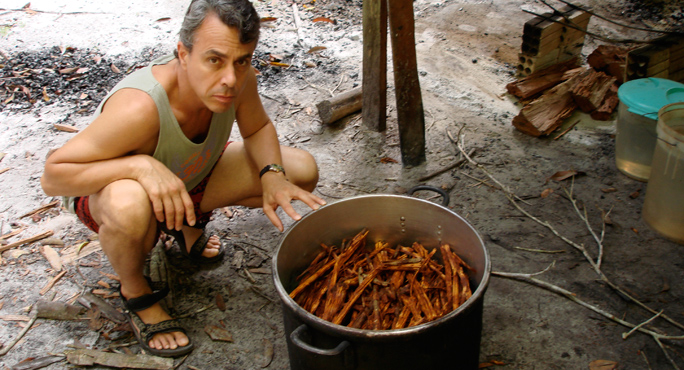Chris with Ayahuasca, Peruvian Amazon
Add to the long list of celebrities who have struggled with drug addictions, the recently deceased 27-year-old British soul diva Amy Winehouse. Every newspaper and magazine will play and replay her final days, and commentators will come out of the woodwork offering thoughtful opinions abut how to deal with talented and troubled individuals who fall into the deep end of the drug pool. However the story sorts out over time, one thing is certain—Winehouse had a drug problem, and couldn’t get out of it. And so, at a very early age, she is one more casualty in the drug-addled celebrity club.
The problem of treating drug addiction is neither simple nor straightforward. A person’s entire biology and psychology play into addiction and dependence, and the threads that weave a tapestry of drug troubles are usually highly complex. Amidst the panoply of offerings, treatments with potent psychedelic substances suggest another line of potentially effective treatment for drug problems. The term psychedelic means soul-manifesting, and was coined in 1957 by psychiatrist Humphry Osmond. These psychedelics include LSD, peyote, ayahuasca, iboga, and other plant or fungus drugs, such as Psilocybin mushrooms. As strange as this may seem at first blush, there is a great deal of work happening in this field.
One agent of change for those struggling with drugs is Ayahuasca, a brew made in the Amazon. Made from a vine (Banisteriopsis caapi) and a leaf (Psychotria viridis), and containing the potent psychedelic compound DMT, ayahuasca produces visions and is used to treat diseases of the body, mind and spirit. Over the past several years ayahuasca has been highly publicized in print and on TV for its unusual healing properties, including stopping drug addictions. One large Brazilian-based Christian church, Santo Daime, conducts ceremonies all over the world, using ayahuasca as a sacrament for the direct experience of spirit. Santo Daime claims thousands of successes with people who ostensibly have been freed of drug addictions by participating in the consumption of the psychoactive ayahuasca brew. Many who have formerly struggled with tobacco, alcohol, cocaine, heroin, methamphetamine and other dangerous drugs have been able to shed their addictions. Additionally, thousands of people from around the world are making pilgrimages to the Amazon, to drink ayahuasca with shamans, and to be healed from a broad range of physical and mental disorders. At this point, people are not waiting for a green light from any health agencies.
According to Dr. Dennis McKenna and other researchers investigating ayahuasca and brain chemistry, the brew appears to normalize levels of critically important brain chemicals, including dopamine. This compound is essential to the experience of satisfaction, and is reduced in cases of drug addiction and dependence. In native ceremonies and in church settings, ayahuasca appears to produce rapid changes in many cases. While the ways that ayahuasca helps some people to overcome addictions is not entirely understood, the volume of people claiming success with addiction or dependency points to something well worth knowing much more about.
Click here to see this intriguing paper on ayahuasca and addictions, by Dr. Jacques Mabit.
Another psychedelic plant drug garnering attention for addiction treatment is the west African plant Iboga (Tabernanthe iboga), and its primary alkaloid ibogaine. An entire ibogaine-based addiction treatment underground exists wordwide, due to the reputedly remarkable efficacy of taking this drug. In Gabon where iboga is use ceremonially, the event takes 24 hours. Typically participants experience visions, deep thoughts, and a sense of being refreshed and restored overall. Iboga is said to “re-set” the chemicals of the brain, and to shed the biological and mental inclinations to abuse a particular substance.
While most people will not travel to Gabon or Congo to participate in a traditional ceremony with iboga, they can and do find treatment centers and gatherings where the active compound ibogaine can be used. Ibogaine enjoys a large body of investigation for its anti-addictive benefits, and the compound is also the subject of at least four patents for the treatment of addictions. FDA has approved at least one study of addiction and ibogaine treatment, and the National Institute on Drug Abuse is looking into multi-site studies of ibogaine for addiction treatment. Erowid vaults provides a good synopsis of ibogaine and the current state of addiction research with this potent visionary plant drug.
Another psychedelic, the cactus peyote, also shows promise for the treatment of drug problems. The Native American Church uses and dispenses peyote in its legally-sanctioned religious ceremonies all over the United States. Many people have sought these ceremonies to deal with drug addiction and dependency, and reports of cures are too many to ignore.
This is not an endorsement to venture forth and consume psychedelics. But there is unquestionable promise in the careful and judicious use of some psychoactive plants for the treatment of drug-related problems. Combined with other lifestyle approaches including counseling, detox, diet and exercise, the psychedelic drugs may eventually occupy a distinguished spot in the full pharmacy of addiction treatment options.


